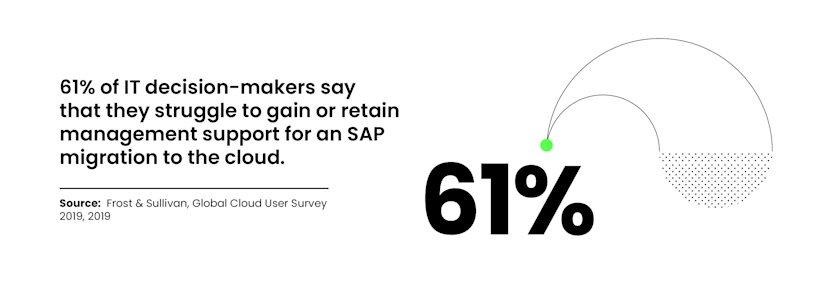
5 Facts You Should Know about S/4HANA Migrations
With 35,000 companies currently buying, implementing, or running on SAP S/4HANA, there’s hardly any topic being discussed as intensively among CIOs, IT leaders, and CFOs than the switch to SAP’s new cloud ERP.
Sure, with SAP putting an end-of-life support date on ECC, many SAP users won’t have much of a choice but to switch to S/4HANA. But that doesn’t mean you should go blindly into this adventure. Because switching the backbone of your operations — be it from SAP ECC to S/4HANA or any other kind of system migration (think Oracle Fusion, Workday, Infor ERP)— is a tricky endeavor to say the least. Without a bulletproof rollout strategy in place, system migrations come with a myriad of challenges and potential pitfalls that can disrupt your business and put your value realization at risk (regardless of the promises SAP makes with their new offering SAP RISE).
Read our System Migration Report to learn more about the risks, challenges, and benefits of system migrations.

That's why we’ve sifted through dozens of benchmark studies, SAP customer surveys, and independent vendor reports about migrating to S/4HANA so that you don’t have to. The result? 5 strategy-defining stats you should know when you’re considering migrating — or have already started to move — to SAP’s newest ERP in the cloud.
1. S/4HANA: Businesses embrace digital transformation — will their ERP follow?
To drive digital transformation and better business outcomes, upgrading or replacing your legacy software will become inevitable. After all, you can't support the business models of tomorrow — on-demand, digital, mobile-first, global — with yesterday's technology.
So will every company running on SAP move to SAP S/4HANA? Maybe not every company. But this is a watershed moment for SAP customers. Many of them are haunted by the same doubts and questions: Can they stay competitive with their current SAP ERP system? And if not, will the ROI outweigh the risks and efforts coming along with the move to S/4HANA? If they decide to migrate, when is the best moment to start?
In a recent survey of nearly 170 companies using SAP, SAPinsider asked about their plans to migrate to SAP S/4HANA. This is where they stand.

2. The entire business needs to be on board with your migration process
No IT leader, CFO, or CIO will jump for joy when they embark on a system migration initiative. Complex projects like an S/4HANA migration come with a hefty price tag and serious risks. Some never get off the ground at all, like Lidl. The German retailer spent €500M ($580M) and seven years migrating to a new company-wide inventory management system, before giving up and reverting back to their old home-grown solution.

Since horror stories like these are not uncommon, it’s no wonder that 61% of IT leaders in a 2019 Frost & Sullivan Global Cloud User Survey said that they struggle to gain or retain management support for an SAP migration to the cloud.At the same time, 62% said that they don’t have sufficient budget to complete their cloud implementation strategies. The problem: These initiatives often arise out of necessity rather than strategy, be it new vendor requirements, changing business needs, or mergers and acquisitions. As a result, both IT and business leaders often treat them as a tactical IT project rather than an enterprise-wide strategic transformation, resulting in under-planning and then missing out on significant opportunities to deliver business value.
Using the data in your source systems to get an end-to-end view of your processes across all systems, is therefore the first step to success. Only with an objective understanding of the status quo can you start defining your IT requirements for a system transformation, build a compelling business case for migration, and draft a clear roadmap that both IT and the business side can get (and stay) behind.
Planning a system migration? Here are 6 stats to get it right
7 reasons why system migrations fail — and how you can avoid them
System migration step by step: The 5-step checklist for your migration project
3. Most companies can’t — and shouldn’t — do it alone
There’s no doubt that migrating to S/4HANA comes with a host of IT- and process-related challenges. Since companies often lack the right migration expertise in-house, a large number of businesses will decide to engage with expert partners. They usually offer support at several stages throughout the S/4HANA migration, from workload assessment to putting together a migration plan, to process mapping, deployment, adoption management, and ongoing management.

Getting support for your IT team is a great idea. But greater business value is not a given, even if you bring in a team of external consultants. Why? Because typical methods of process mapping — like workshops, surveys, or time studies — are often subjective and incomplete. That’s why the most forward-thinking companies and consultants themselves often draw on additional technologies to get a data-driven picture of their processes. Only with 100% visibility across your process landscape, can you fully understand the downstream impact of changes and deprecations.
“There is no doubt we've embraced Process Mining as an essential part of our S/4HANA transformation approach. It has become an integrated fact-based navigator throughout the transformation journey,” confirms Marcus Messerschmidt, partner at PwC CIO Advisory. As he puts it: programs of this size and complexity require the best of both worlds – data and expert knowledge – to meet the high expectations of everyone involved. “In our experience, you have to combine being data-driven with established best practices to achieve the best results.”
4. Most companies configure S/4HANA from scratch
When migrating from ECC to S/4HANA, SAP-run businesses have to decide on their approach very early on. Should they rip and replace all their systems (greenfield)? Should they “lift and shift” their legacy system’s configuration onto the new system (brownfield)? Or should they cherry-pick what they migrate and where they stick to the standard (bluefield)?
According to Gartner, the greenfield implementation still continues to be the approach of choice for more than half of the market. However, Gartner expects brownfield conversion and bluefield migrations to flourish in the next few years, when SAP clients who still “watch and wait” will eventually migrate from SAP ECC to S/4HANA ahead of the end-of-support deadline in 2027.

At first sight, it seems only logical that companies want to preserve their existing investment and the customization of their processes. And sure, it looks like the easiest, least disruptive path forward. But a net-new S/4HANA implementation gives you the opportunity to free your existing systems and processes from the baggage accumulated over the years (or even decades).
It’s a complex operation, yes, but a more standardized, connected, and modern landscape can boost your business efficiency and flexibility in the future. On the other hand, those kinds of implementations require bigger organizational and structural changes, since you’ll have to work without internal best practices and might struggle with slow user adoption.
Every strategy has its pros and cons, and what works for your organization heavily depends on what your processes look like today. That’s why data-driven insight into your as-is process performance is so crucial for revealing the complexities and best practices that will inform your rollout strategy.
5. The top drivers behind S/4HANA migrations
Every company’s process landscape is unique. It may encompass everything from highly-customized applications essential to your business to decades-old processes and a bunch of homegrown, disparate systems that don’t play well together. Some of them you need, some of them you don’t. Indiscriminately heaving all of your processes into your new IT landscape is like moving into a new house without decluttering your attic and cellar first. Especially when migrating to S/4HANA, you should think about which customizations you actually need and which are just inherited. Highly customized processes and code can hinder adoption and your ability to take full advantage of the latest SAP functionalities.
Consequently, in SAP Insiders’s 2021 Migration Benchmark Report, respondents name reengineering or correcting poor processes and configurations from a previous ERP implementation as the top driver for their S/4HANA migration.

How to get your SAP S/4HANA migration right
System migrations offer huge opportunities for IT to drive the business forward, to facilitate game-changing innovation, and to act as a strategic force in the enterprise. Whether you’re considering migrating or are already moving to S/4HANA, starting your migration on the right foot is key to delivering real business outcomes. Our Road to Go-Live Handbook can give you the head start you need. Read in detail about some of the major challenges experienced by IT leaders throughout their system migration and how the Celonis Execution Management System can help at every step of the way.




